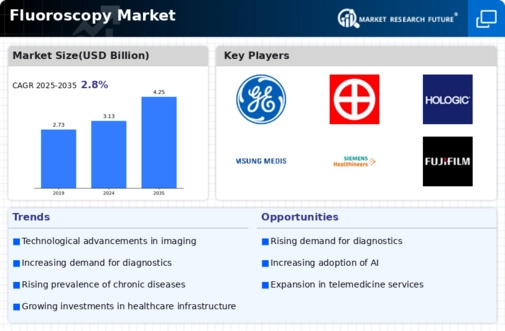Rising Demand for Diagnostic Imaging
The increasing prevalence of chronic diseases and the aging population are driving the demand for diagnostic imaging solutions, including fluoroscopy. As healthcare providers seek to enhance patient outcomes, the Fluoroscopy Market is experiencing a notable uptick in utilization. According to recent data, the market is projected to grow at a compound annual growth rate of approximately 5.2% over the next several years. This growth is largely attributed to the need for accurate and timely diagnoses, which fluoroscopy provides through real-time imaging capabilities. Furthermore, advancements in imaging technology are likely to improve the efficiency and effectiveness of fluoroscopic procedures, thereby attracting more healthcare facilities to adopt these systems. Consequently, the rising demand for diagnostic imaging is a pivotal driver for the Fluoroscopy Market.
Regulatory Support and Safety Standards
Regulatory support and the establishment of stringent safety standards are vital drivers for the Fluoroscopy Market. Regulatory bodies are increasingly emphasizing the importance of patient safety and the need for high-quality imaging solutions. This has led to the implementation of guidelines that promote the use of advanced fluoroscopy systems that minimize radiation exposure while maximizing diagnostic efficacy. Compliance with these regulations is essential for healthcare providers, which in turn drives the demand for updated fluoroscopic equipment. The market is likely to benefit from ongoing regulatory initiatives aimed at enhancing the safety and effectiveness of imaging technologies. As a result, the Fluoroscopy Market is positioned to grow in response to these regulatory frameworks that prioritize patient care.
Integration of Advanced Imaging Technologies
The integration of advanced imaging technologies into fluoroscopy systems is transforming the landscape of the Fluoroscopy Market. Innovations such as digital fluoroscopy, 3D imaging, and enhanced image processing capabilities are enhancing the quality of diagnostic imaging. These advancements not only improve the accuracy of diagnoses but also reduce radiation exposure for patients. The market is witnessing a shift towards systems that incorporate artificial intelligence and machine learning, which can assist radiologists in interpreting images more effectively. As healthcare providers increasingly prioritize patient safety and diagnostic precision, the adoption of these advanced technologies is expected to accelerate. This trend indicates a promising future for the Fluoroscopy Market, as it aligns with the broader movement towards modernization in healthcare.
Increased Investment in Healthcare Infrastructure
Increased investment in healthcare infrastructure is a significant driver for the Fluoroscopy Market. Governments and private entities are allocating substantial resources to enhance healthcare facilities, particularly in emerging economies. This investment often includes the procurement of advanced medical imaging equipment, including fluoroscopy systems. As healthcare systems expand and modernize, the demand for fluoroscopic imaging is expected to rise, driven by the need for improved diagnostic capabilities. Market analysis indicates that regions with robust healthcare infrastructure development are likely to see a surge in fluoroscopy utilization. This trend not only supports the growth of the Fluoroscopy Market but also reflects a commitment to improving healthcare access and quality.
Growing Preference for Minimally Invasive Procedures
The growing preference for minimally invasive procedures is significantly influencing the Fluoroscopy Market. As patients and healthcare providers alike recognize the benefits of such procedures, including reduced recovery times and lower risk of complications, the demand for fluoroscopic guidance in these interventions is on the rise. Fluoroscopy plays a crucial role in various minimally invasive surgeries, such as catheter placements and biopsies, by providing real-time imaging that enhances precision. Market data suggests that the adoption of fluoroscopy in these procedures is expected to increase, driven by advancements in technology and a shift in surgical practices. This trend not only supports the growth of the Fluoroscopy Market but also reflects a broader transformation in surgical methodologies.























Leave a Comment